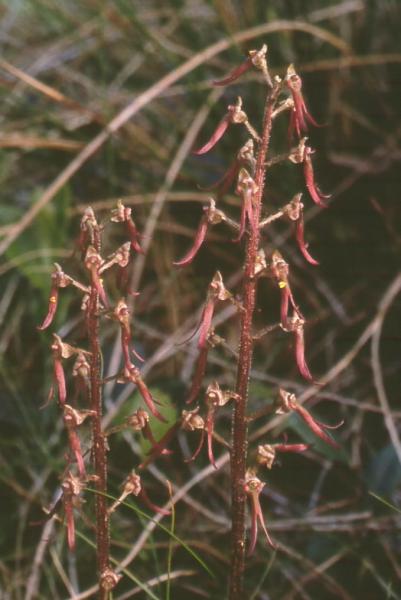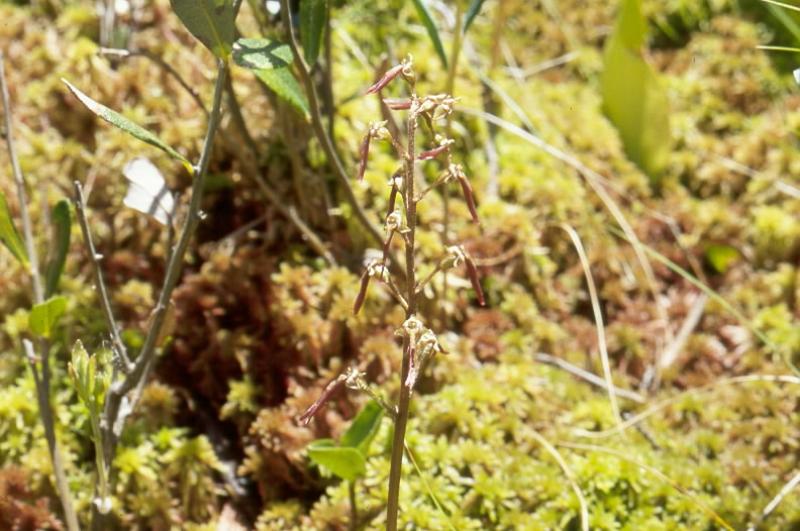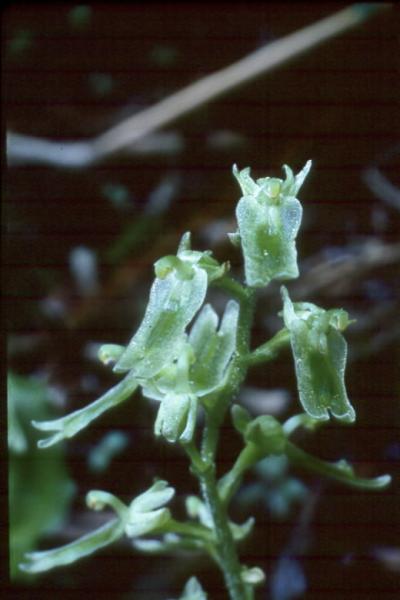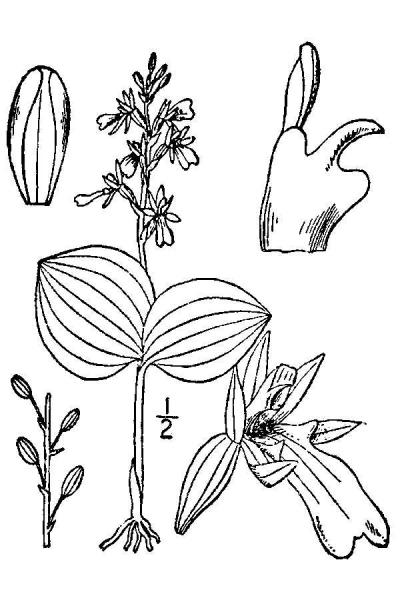Southern Twayblade
Neottia bifolia (Raf.) Baumbach
- Class
- Monocotyledoneae (Monocots)
- Family
- Orchidaceae (Orchid Family)
- State Protection
- Threatened
Listed as Threatened by New York State: likely to become Endangered in the foreseeable future. For animals, taking, importation, transportation, or possession is prohibited, except under license or permit. For plants, removal or damage without the consent of the landowner is prohibited.
- Federal Protection
- Not Listed
- State Conservation Status Rank
- S2
Imperiled in New York - Very vulnerable to disappearing from New York due to rarity or other factors; typically 6 to 20 populations or locations in New York, very few individuals, very restricted range, few remaining acres (or miles of stream), and/or steep declines.
- Global Conservation Status Rank
- G4
Apparently Secure globally - Uncommon in the world but not rare; usually widespread, but may be rare in some parts of its range; possibly some cause for long-term concern due to declines or other factors.
Summary
Did you know?
There are four species of Listera in New York and all of them are rare except Listera cordata, the heartleaf twayblade. These orchids are often very hard to see and great care must be taken when searching for them to avoid trampling. The small aboveground stem may not appear every year and when it does it only lasts for a few weeks. The genus name is dedicated to Martin Lister, 1638-1711, a famous English naturalist.
State Ranking Justification
There are 10 known populations but half of these are relatively small. One large site contains approximately 2000 plants. There are roughly 20 historical populations that should be surveyed. There are undoubtedly more populations still to find.
Short-term Trends
A few populations have disappeared, despite repeated efforts to relocate these. However, a few new populations have been located. These new populations were likely present at these sites for many years, but infrequent surveys failed to locate them. Overall, there has probably been a slight decline in the total number of plants over the past 100 years, but with greater protection to wetlands these declines have likely stabilized.
Long-term Trends
As bogs, fens, and other wetlands were converted to muck farms or otherwise drained, populations were undoubtedly lost. These threats are minimal today. The number of populations that may have been lost after European settlement is impossible to assess, but speculation leads to the belief that there was at least a slight to moderate decline.
Conservation and Management
Threats
Today there are few threats that impact this species. Run-off may have some impact, but this is not well studied. Much of the habitat where this plant might be found is either protected on public land or subject to wetland protection laws.
Conservation Strategies and Management Practices
No direct management requirements are needed for this orchid except to protect the sites where populations occur. This should include protection to any waterways that may influence the populations.
Research Needs
More research is needed on the habitat requirements so targeted surveys may be conducted. A computer distribution model may be helpful in locating new populations.
Habitat
Habitat
A plant of peat moss areas including bogs, poor fens, and wet woods (New York Natural Heritage Program 2005). Rich humus of low moist woods, marshes, sphagnum bogs, usually in association with rhizomes of cinnamon fern (Osmunda cinnamomea) and royal fern (O. regalis) (Flora of North America 2002). Very rare in bogs (Rhoads and Block 2000). Shaded bogs and wet woods (Gleason & Cronquist 1991). Damp woods or, northward, sphagnous thickets and bogs (Fernald 1970).
Associated Ecological Communities
- Black spruce-tamarack bog
(guide)
A conifer forest that occurs on acidic peatlands in cool, poorly drained depressions. The characteristic trees are black spruce and tamarack; in any one stand, either tree may be dominant, or they may be codominant. Canopy cover is quite variable, ranging from open canopy woodlands with as little as 20% cover of evenly spaced canopy trees to closed canopy forests with 80 to 90% cover.
- Coastal plain poor fen
(guide)
A wetland on the coastal plain fed by somewhat mineral-rich groundwater and slow decomposition rates of plant materials in the wetland (and thus develops peat). Plants are generally growing in peat composed primarily of Sphagnum mosses with some grass-like and woody components.
- Dwarf shrub bog
(guide)
A wetland usually fed by rainwater or mineral-poor groundwater and dominated by short, evergreen shrubs and peat mosses. The surface of the peatland is usually hummocky, with shrubs more common on the hummocks and peat moss throughout. The water in the bog is usually nutrient-poor and acidic.
- Highbush blueberry bog thicket*
(guide)
A wetland usually fed by rainwater or mineral-poor groundwater and dominated by tall shrubs and peat mosses. The most abundant shrub is usually highbush blueberry. The water in the bog is usually nutrient-poor and acidic.
- Inland poor fen
(guide)
A wetland fed by acidic water from springs and seeps. Plant remains in these fens do not decompose rapidly and thus the plants in these fens usually grow on older, undecomposed plant parts of mostly sphagnum mosses.
- Red maple-blackgum swamp
(guide)
A maritime, coastal, or inland hardwood swamp that occurs in poorly drained depressions, sometimes in a narrow band between a stream and upland. Red maple and blackgum are often codominant or blackgum may be the dominant tree. Pitch pine may occur on drier hummock islands in pine barrens settings.
- Red maple-hardwood swamp
(guide)
A hardwood swamp that occurs in poorly drained depressions, usually on inorganic soils. Red maple is usually the most abundant canopy tree, but it can also be codominant with white, green, or black ash; white or slippery elm; yellow birch; and swamp white oak.
- Red maple-tamarack peat swamp
(guide)
A swamp that occurs on organic soils (peat or muck) in poorly drained depressions. These swamps are often spring fed or enriched by seepage of mineral-rich groundwater resulting in a stable water table and continually saturated soil. The dominant trees are red maple and tamarack. These species usually form an open canopy (50 to 70% cover) with numerous small openings dominated by shrubs or sedges.
* probable association but not confirmed.
Associated Species
- Calopogon tuberosus
- Chamaedaphne calyculata (leatherleaf)
- Clethra alnifolia (coastal sweet-pepperbush)
- Decodon verticillatus (water-willow)
- Drosera rotundifolia (round-leaved sundew)
- Nemopanthus mucronatus
- Osmunda cinnamomea
- Osmunda regalis
- Rhynchospora alba (white beak sedge)
- Rubus hispidus (swamp dewberry)
- Sphagnum
- Sphagnum magellanicum
- Sphagnum rubellum
- Symplocarpus foetidus (skunk-cabbage)
- Triadenum virginicum
- Trientalis borealis
- Vaccinium corymbosum (highbush blueberry)
- Vaccinium macrocarpon (cranberry)
- Vaccinium oxycoccos (small cranberry)
Range
New York State Distribution
The orchid has a split distribution within New York. Some of the larger populations are located along the Coastal Plain of Long Island, but populations have been reported over a widely scattered area that ranges from the Adirondacks into central and western New York. New York is near this orchid's northern limit.
Global Distribution
This orchid is found in scattered locations of southern Quebec, southern Ontario, northern Vermont, New York, northern Pennsylvania, and New Jersey. It is also found more commonly in the southeastern US along the Coastal Plain from Virginia to Texas. Since this orchid is easily overlooked, there is a chance that the range is even broader than this.
Identification Comments
General Description
Southern twayblade is a small and difficult to find orchid rarely over six inches high. It has twinned or a single pair of stiff leaves that occur in the middle of the stem. The leaves are spoon-shaped and are rich blue-green in color. Up to 25 flowers are distributed along the upper part of the stem, they are reddish-purple to pale green. Each flower has a narrow, two-pronged lip that may reach 10 mm in length. The flower stalks are shorter than the flowers and are covered with small glands.
Identifying Characteristics
This small orchid is 10-30 cm tall. The ovate leaves are 1-3.5 cm long. The rachis (main axil of inflorescence) and pedicel are glandular. There may be up to 25 flowers per inflorescence, with the flower appearing greenish-purple to dull red. The lip is 6-10 mm long, deeply cleft into linear lobes that point outward, with a small tooth at the sinus, and an inversely T-shaped fold at the base. The lip is four times as long as the lateral petals. The column is 1-1.5 mm long.
Best Life Stage for Proper Identification
This plant is best identified by its flowers. Due to its rare nature though, the plant should be documented through a series of photographs. The photos should capture the overall look of the plant as well as close-up images of the flower.
Similar Species
Listera cordata has a rachis and petioles that are glabrous with a lip that is 3-5 mm long and with two projecting lateral teeth near the base. The lip of Listera cordata is twice as long as the lateral petals. Our other Listera species have an uncleft lip with rounded lobes and a column that is more than 1.5 mm long.
Best Time to See
This plant flowers in spring, with peak flowering usually in the first two weeks of June. In the northern part of the state, flowering plants may be present until the end of July while along the Coastal Plain they begin to fade by late June. Even when flowering, this small orchid can be difficult to locate. Surveys should be conducted in the first few weeks of June or even late May on Long Island.
- Flowering
- Fruiting
The time of year you would expect to find Southern Twayblade flowering and fruiting in New York.
Southern Twayblade Images
Images of Similar Species
Taxonomy
Southern Twayblade
Neottia bifolia (Raf.) Baumbach
- Kingdom Plantae
- Phylum Anthophyta
- Class Monocotyledoneae
(Monocots)
- Order Orchidales
- Family Orchidaceae (Orchid Family)
- Order Orchidales
- Class Monocotyledoneae
(Monocots)
- Phylum Anthophyta
Synonyms
- Listera australis Lindl.
- Ophrys australis (Lindl.) House
Additional Resources
Best Identification Reference
Flora of North America Editorial Committee. 2002. Flora of North America, North of Mexico. Volume 26. Magnoliophyta: Liliidae: Liliales and Orchidales. Oxford University Press, New York. 723 pp.
Other References
Fernald, M.L. 1950. Gray's manual of botany. 8th edition. D. Van Nostrand, New York. 1632 pp.
Gleason, Henry A. and A. Cronquist. 1991. Manual of Vascular Plants of Northeastern United States and Adjacent Canada. The New York Botanical Garden, Bronx, New York. 910 pp.
Holmgren, Noel. 1998. The Illustrated Companion to Gleason and Cronquist's Manual. Illustrations of the Vascular Plants of Northeastern United States and Adjacent Canada. The New York Botanical Garden, Bronx, New York.
New York Natural Heritage Program. 2010. Biotics database. New York Natural Heritage Program. New York State Department of Environmental Conservation. Albany, NY.
New York Natural Heritage Program. 2024. New York Natural Heritage Program Databases. Albany, NY.
Reschke, Carol. 1990. Ecological communities of New York State. New York Natural Heritage Program, New York State Department of Environmental Conservation. Latham, NY. 96 pp. plus xi.
Rhoads, Ann F. and Timothy A. Block. 2000. The Plants of Pennsylvania, an Illustrated Manual. University of Pennsylvania Press, Philadelphia, PA.
Voss, E.G. 1972. Michigan Flora, Part I. Gymnosperms and Monocots. Cranbrook Institute of Science Bulletin 55 and the University of Michigan Herbarium. Ann Arbor. 488 pp.
Weldy, T. and D. Werier. 2010. New York flora atlas. [S.M. Landry, K.N. Campbell, and L.D. Mabe (original application development), Florida Center for Community Design and Research http://www.fccdr.usf.edu/. University of South Florida http://www.usf.edu/]. New York Flora Association http://newyork.plantatlas.usf.edu/, Albany, New York
Links
About This Guide
Information for this guide was last updated on: August 28, 2019
Please cite this page as:
New York Natural Heritage Program. 2024.
Online Conservation Guide for
Neottia bifolia.
Available from: https://guides.nynhp.org/southern-twayblade/.
Accessed July 26, 2024.



